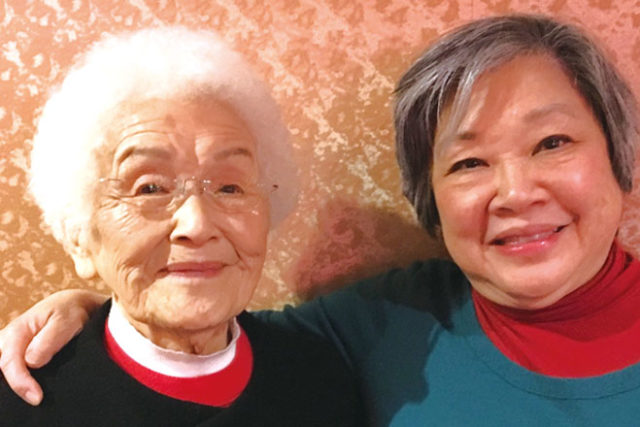By David Yamaguchi
The North American Post
ON DEC. 13, I was among many readers in the sold-out theater at Lincoln Square Cinemas, Bellevue, to see the film version of the Broadway musical “Allegiance.” The film draws from the life of actor George Takei, who spent ages 5-9 at the Heart Mountain and Tule Lake internment camps.
By way of background, I attended the screening with mixed feelings. For despite my article advertising it (Dec. 1), sometimes I think that Japanese Americans dwell too much on World War II internment. This community focus results in deficits in our understanding of other important aspects of life. This includes developing a better understanding of our Japanese cultural roots.
With this mindset then, I will say that I was completely swept away by the film. Tears, which do not lie, were welling in my eyes throughout.
DURING THE LENGTHY screening (“Allegiance” runs 2-1/2 hours), I was struck with varying thoughts:
1. How, on finding the right theater in the multiplex, not a single poster advertised it. For “Allegiance” had appeared only as a one-time special showing. Apparently, it was deemed not worth the effort to post anything.
2. How, at age 59, it remains rare for me to have the chance to see actors who resemble me speaking English on film and stage.
3. The effectiveness of a musical as a format for retelling the defining JA story. Seemingly too heavy a topic to present in song, photographer Gwen Shigihara explained to me the strategy behind the format. As Asian Americans tend to be more reserved than others in daily life, lyrics provide a vehicle for conveying inner emotions that would be unrealistic for actors to say in words.
5. How the play tells the story effectively in broad strokes.
6. The play’s boldness in sketching the controversial role of Mike Masaoka, default spokesperson for the wartime JA community nationally. Mr. Masaoka urged cooperation with the government, and later, volunteering for military service from the camps. Similarly raised is the open question of whether Texas soldiers would have rescued JA ones if their roles had been reversed in the Battle of the Bulge, and it was the 442nd infantry who were trapped behind German lines.
7. How wonderful it must have been for the few Nisei present to watch their lives unfold on screen.
8. How lucky the producers were to get Lea Salonga, the songstress of the Broadway productions of “Miss Saigon” and “Les Miserables.”
9. How the musical prompted me to ponder a question new to me: what would have happened if JAs hadn’t cooperated with government orders to report to posted assembly points for internment? The government would have been forced to stretch its resources to the limit (soldiers, holding cells, transportation) to round them up one by one. It would have refocused attention on whether internment justified the effort and expense. But that is the subject for another movie.
THE FILM VERSION of “Allegiance” includes a “making of” documentary, which is shown contiguous with the main feature. A few in the Lincoln Square audience missed the supplement by exiting the theater before the main-film credits stopped rolling.
In the supplement, one learns that 120,000 people saw the New York live-theater performance, eerily matching the number of JAs interned. The story’s educated white co-writers, Marc Acito and Lorenzo Thione, also confess their not having previously heard of JA internment. (How is this possible?)
Also mentioned is the joy the project created for New York Asian-American actors. While normally they are scattered among the various productions of the 43 theaters lining Broadway, there they were, all in the same show!
THE NEXT OPPORTUNITY to view “Allegiance” will be an encore screening on Sunday, Feb. 19, at 12:55 p.m., presumably again at AMC theaters nationally (Pacific Place, Southcenter, Lincoln Square, etc.). Note that this is the Day of Remembrance, around which there will likely be other community activities commemorating the 75th anniversary of Executive Order 9066 that set in motion JA internment. Tickets will go on sale Jan. 23 (allegiancemusical.com, fathomevents.com).
TO END on a more personal note, I was pleased, wending my way through the Lincoln Square shopping center to the theater, to cross paths with International Examiner columnist Sharon Maeda and her charming, 97-year-old mother, Molly Maeda. Like many Seattle natives, the three of us were semi-lost, away from our side of the pond. And so we followed Eastside local Gwen—like ducklings after their mother—through the 3-D maze of the center.
As we walked, Mrs. Maeda commented that she knows two Yamaguchi’s: Kay and David. She elaborated how she had worked at the desk behind Kay’s in the Minidoka Administration Building. She had known him well.
“Kay worked so hard,” she said.
Later, Mrs. Maeda remembered a third Yamaguchi, “Sue,” who held down the front desk at the Todas’ Vision Clinic on Jackson.
“Is she your mother?” she asked.
“Kay was my dad,” I was proud to reply. “I am David. Sue was my aunt, married to Uncle Min.”
Memories like Mrs. Maeda’s are reasons enough for me—in fact, for all of us—to keep writing.







